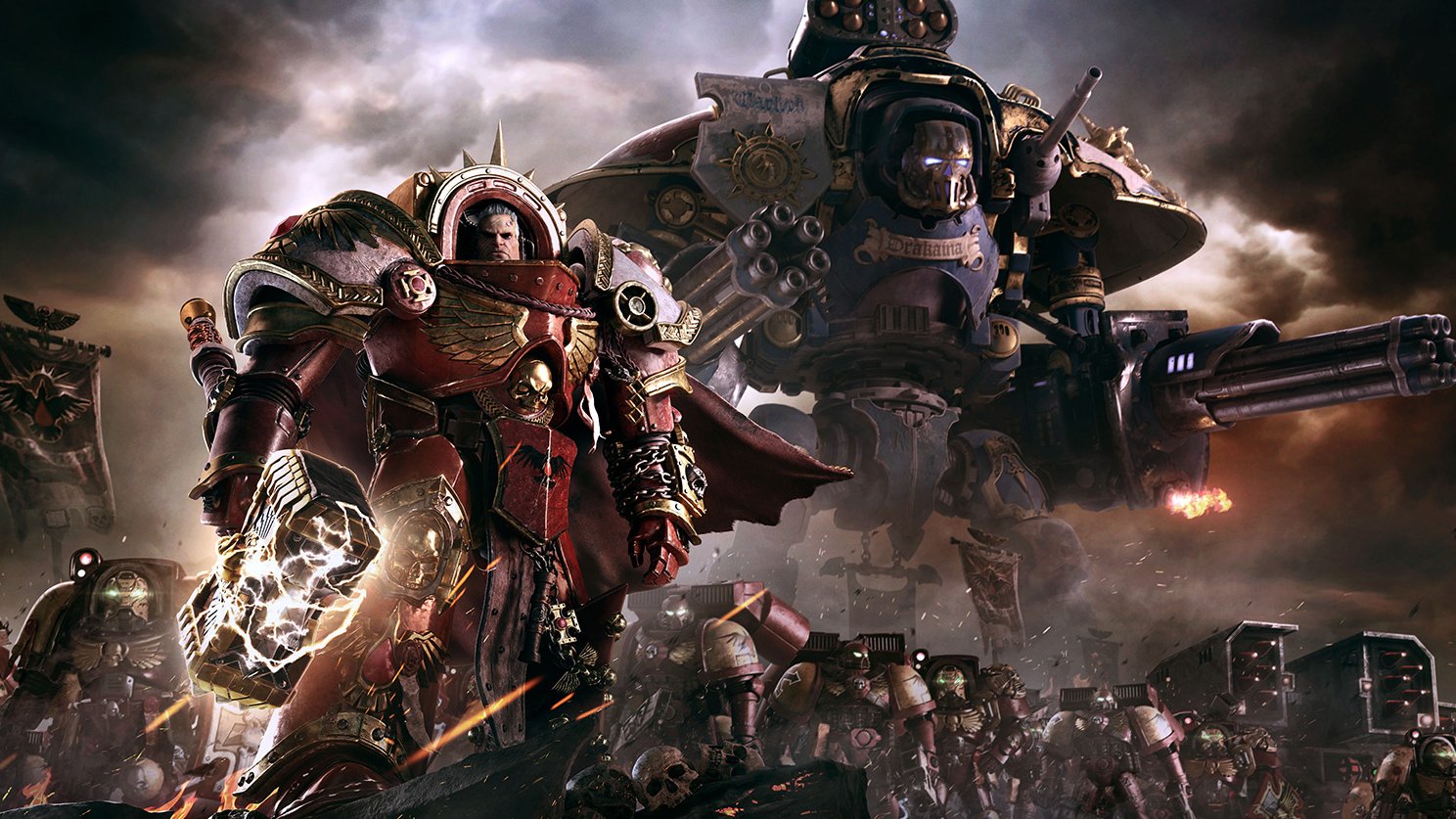Our Verdict
Dawn of War 3 has overly dominant elites, and a merely serviceable campaign, but it captures the power of mass battles well.
PC Gamer's got your back
What is it? The latest reinvention of the Warhammer RTS series, this time with a MOBA-influenced multiplayer mode.
Expect to pay $60/£40
Developer Relic Entertainment
Publisher Sega
Reviewed on Windows 10, 16GB RAM, GeForce GTX 980
Multiplayer Yes, with up to 6 players.
Link Official site
Buy it CDKeys
Read our affiliates policy.
Outlandish swagger seeps through every pixel of Warhammer 40,000: Dawn of War 3, and I can't help but admire it. Here we find a future so advanced that people flit about in spacecraft as easily as we take the bus, and yet one of its greatest heroes is a guy wielding a big frickin' hammer.
And oh, how he uses it. The man is Gabriel Angelos, commander of the Blood Ravens of the Space Marines, and he leaps into piles of orks and sends them flying as effectively as Chris Farley cannonballing a balsa coffee table. I press another hotkey and his hammer swings 360 degrees, causing orc blood and guts to splatter the turf and walls in gruesome imitation of Jackson Pollock. I may have grown weary of other elements in the latest entry in Relic Entertainment's long-running real-time strategy franchise, but from start to finish I admired the gusto of its presentation.
Dawn of War 3 is all about recapturing that classic real-time strategy excitement. Much of the time it succeeds. It accomplishes it not only with (literally) larger than life elite units like Gabriel, but also by stuffing in massive-screen hogging armies, limited base-building, and squabbles over resource nodes. Some good elements from the past get lost in the process, such as the cover system and Diablo-style loot hunts that helped make 2009's Dawn of War 2 so exciting, but nothing shines so brightly in this new dawn as the emphasis on unrelenting, aggressive action. What it lacks in creative scenarios it makes up for in intensity, to the point that I rarely found myself bored in both multiplayer and the campaign.
With a better story, Dawn of War 3 may have even been magnificent. It certainly has the ingredients on hand—a dash of old, favorite characters like the Eldar's Farseer Macha and a crunchy pinch of the Orkish warboss Gorgutz 'Ead 'Unter—but it squanders it on an unappetizing tale about the humans, Orks, and Eldar (space elves) brutally bickering over a mysterious spear and some business about a runaway planet. There's war! There's betrayal! Wacky alliances emerge! In other words, well, it's essentially Warhammer as usual.
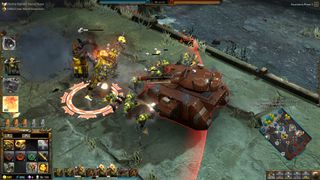
It's been a long time since I've felt such a satisfying buildup in an RTS.
The big difference this time around is that Dawn of War 3 lets you play all three factions in the 17-mission campaign rather than limiting yourself to the Space Marines. Each bunch feels distinct, and I found experimenting with each one of the greatest joys Dawn of War has to offer. The Space Marines may be a straightforward bunch with swords and guns, but they march down that straight path with panache, mowing down Orks and Eldar with hulking mechs or smashing through walls of green flesh with Gabriel's big hammer. The Eldar, though, are a band apart. Lithe and lean, they dart across the battlefield with rechargeable shields and an emphasis on strike-and-run tactics, and they can teleport almost all of their base's structures across the field rather than build a new one.
But it's the Orks that steal the show. They can upgrade themselves with the scrap from ruined buildings littering the field, and every one of their ramshackle structures invites admiration. Nothing sets them apart quite like their WAAAAGH towers, though, which look like things that might be loaded on Mad Max: Fury Road's doof wagon and which pump thumpin' heavy metal out to the green hordes around them. Activate one—hell, activate five of them—and the music intensifies until the surrounding orcs revel in a savage ecstasy, gaining enough attack boosts and speed to knock some hurt into anyone who comes near. It's been a long time since I've felt such a satisfying buildup in an RTS.
It can get tough to see all these units in action, particularly when the screen floods with little green men (that do drag the framerates down to around 40 frames per second or so), but the intuitive user interface usually smooths out any potential issues. Every squad that's either in the field or being prepared gets its own little square at the bottom of the screen, making it easy to keep track of which ones are taking heavy fire and need to be directed over to a health boost. They also make it easy to tell which units need to be upgraded, as the icon changes once the upgrade is in place to reflect the newer look.
Such variety. Such potential. But for all of the creativity that went into making each faction feel distinct, only a little made it into the maps themselves. A fairly typical mission might see me stepping into the clanky shoes of an elite like Gorgutz and directing my guys to muscle their way from one point to another, smashing whatever objective was there, and capturing resource nodes throughout the map. I'd then set up a few base buildings like barracks and an advanced vehicle shop, and then take the battle to whoever was on the other side. And that, sadly, would usually be that.

Dawn of War 3 has limited graphics options, but should run well on modern hardware. Read our comprehensive Dawn of War 3 performance and settings analysis to find out how well your system will render its battles.
The lack of creativity fortunately doesn't mean a lack of content. At least the missions are long; their objectives neatly scattered. It took perhaps half an hour to plow through the shortest one, and the longest one took a couple of hours out of me. But the pacing isn't always perfect. Even on some of the most intense maps, I still found myself in plenty of situations where I'd end up waiting quietly and awkwardly for resources to pick back up so I could enter some more units into the queue. Worse, at least as far as believable strategy is concerned, in almost every one of these vulnerable cases the enemy showed next to zero interest in taking me out. Cover might as well not exist at all. Sure, you'll find a couple of circular areas with destructible shields across the map, but the battles rarely seem to take place near them.
For better or for worse, it's usually safe to expect a dull campaign from a real-time strategy game. After all, the joke-that's-not-a-joke goes that they're really only meant as lengthy tutorials for the multiplayer mode, and that's true here. The catch? Dawn of War 3 does a shoddy job of it. Rather than sending you through multiple missions at a time with a single faction, Relic passes you off to a different faction every mission. I started off with humans, but one mission later I was turning up my nose along with the Eldar. One more, and I was shouting WAAAAAAAGH with the Orks. (That was my favorite.) And then it's "Hey, humies" all over again.
Stomaching this kind of thing might have been easier if the factions played a little more similarly (which would bring its own set of problems), but the factions play so differently that it's tough to get the hang of micromanaging the upgrades for squads, the specific abilities for three elite heroes and their grunt units, and the queues for specific buildings. Just as I'm getting comfortable with the tactics associated with a certain faction, I'm asked to step into another. The narrative suffers a little as a result as well, as the disjointed story does little to foster the cohesion that comes from a focus on one faction.
Sometimes, though, the spectacle of its setpiece kept my attention. I wish there had been more. Early on, for instance, the Orks cobble together a big gun in an inconvenient spot and then realize moving it might pose a few problems. They realize after the first shot that the gun has a massive kickback, so the latter part of the mission hinges of the orcs fighting off Eldar as they warm it up and fire it toward the next point on the map. Dawn of War 3 also revels in the beauty of carnage. Forums and subreddits leading up to the official launch crawled with complaints that it looked too "cartoony," but the graphical approach here generally works well in action. Dawn of War 3 unfortunately doesn't let you zoom in for detail as far as Dawn of War 2, but from afar, the flashy animations for elites make it easy to find them in the flood of fighters.
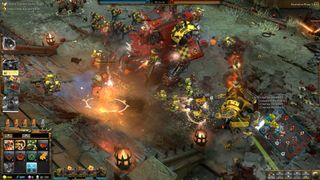
Elites are the mighty hero units that dominate Dawn of War 3. A specter of Warcraft 3 heroes looms over their presence, to the point that Gabriel himself—standing twice the size of his fellow men and toting a two-handed mallet—could be sculpted into a modern-day model for Arthas Menethil with little effort. He leaps into battle with arcs perhaps better suited to comic books than grimdark fantasy and his voice actor clearly enjoy yelling out his goofy, noble lines with weighty conviction. (Sound design as a whole is a great strength throughout.) I admire the surprising variety in both appearance and abilities in all of them. Some, like Farseer Macha, who tosses her spear across the map and unleashes telekinetic blasts, are fairly simple. My personal favorite is likely the Orks' Beauty da Morkanaut, a building-sized walking metal effigy of the Ork god Mork that lumbers through the battlefield taking on entire armies on its own with its devastating "rockit fists" and "kustom force shield."
They're like gods on the field, and I can't shake the feeling that they're too powerful.
They're like gods on the field, and I can't shake the feeling that they're too powerful. That's not to say that they're immortal, as you could take down a melee-focused elite like Gabriel with some smart positioning of snipers and other ranged units. And to be fair, taking one of the giants down is one of the great thrills of the game.
But there's a good chance Gabriel could just jump into that pile of snipers and scatter them anyway. I normally get the most satisfaction from real-time strategy games by lining up a smart succession of grunts troops, but such meticulous efforts come off as a waste of time here when elites crush your armies within seconds. Elites technically can't even die. You first summon elites of varying power by building elite points from passive play (Da Morkanaut takes a hefty 9), but after they fall, you only need to wait out a short timer before you can set them to wreaking havoc again. They're so essential to the strategy here, in fact, that in the multiplayer maps I'd frequently see players just turtling around their base until they had enough points to throw an elite into the field. I can't even say I blame them.
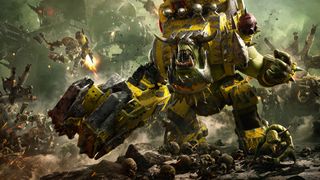
You also gain 'skull' currency by leveling elites through the campaign, but that leveling unfolds at a glacial pace. Skulls allow you to buy new 'doctrines' for your elites, such as one that heals all the troops around Gabriel when he falls in battle. You're clearly meant to build up most skull points through the multiplayer mode, as a fully unlocked stable of abilities allows for loadouts that give you significant edges over your opponents.
And what about that multiplayer mode anyway? (And unfortunately, for now, there is just the one and it only comes with eight different maps.) It, too, hearkens back to real-time strategy's good ol' days of building bases, scrounging for resources, and slapping armies of humans, orcs, and elves together into a giant, scrappy pile in 3-v-3, 2-v-2, or 1-v-1 modes.
But there are more distinctly modern elements here, too. The battles themselves aren't really about destroying bases. Instead, they're about taking down 'power cores,' but not before first taking out sets of shield generators and turrets. In short, in action, Dawn of War 3's multiplayer mode looks a lot like a multiplayer online battle arena in the vein of League of Legends or Dota 2.
I initially wasn't much of a fan of the approach, but it's grown on me. A bit, anyway. The presence of elites and escalation timers mean that smart players are always on the offensive, trying to keep the elites and bay and trying to slap key enemy structures with permanent damage. Most of the best action takes place around resource nodes, as losing them can quickly cripple a faction beyond recovery. Playing defensively? You're probably going to get a few nasty comments in chat from your teammates for not helping out. I've grown to love the associated energy, except perhaps when they devolve into what looks like pure chaos in the 3v3 mode.
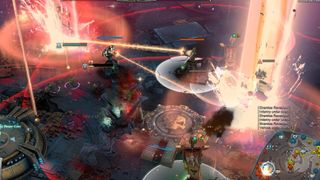
Still, I'm convinced the elites make the battles go on far longer than they should. You can spend several minutes building a smart selection of troops, but they're little more than wheat before the thresher when an elite stomps on the screen. Elites dominate the field so thoroughly that I've sometimes seen matches devolve into two elites just swatting each other in the middle of the field, their armies dead all around them. It's in these moments that they most resemble a MOBA's hero units, and the look isn't always flattering.
Other flaws pepper the experience, too, whether it's the absence of autosaves during the long campaign missions or the mind-boggling inability to reassign keybinds. For all this, I can't say I wasn't usually having fun. I admire Dawn of War 3 for trying to reinvent its formula again. It isn't quite the pure RTS of the first game or the RPG experiment of the second, but it sits somewhere in between. In its finest moments, when armies are crawling over each other and mechs make the ground tremble, it's an exciting place to be.
Dawn of War 3 has overly dominant elites, and a merely serviceable campaign, but it captures the power of mass battles well.

Overwatch's two new theme songs won't make your playlist, but they're perfectly fitting for its post-OWL esports matches

A summer intern once saved Valve from a near-fatal lawsuit after a publisher 'decided to go World War 3' on it, and it all hinged on one email

After dominating The Game Awards in 2023, Baldur's Gate 3 is in the running for even more gold in 2024
